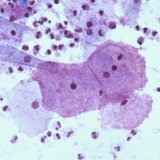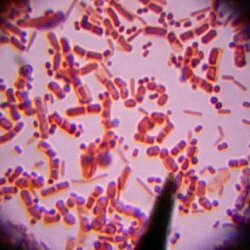Diagnosis and treatment of gardnerellosis
 Gardnerella is a disease accompanied by an increase in the number of Gardnerella bacteria. This disease affects mainly women, as in the body of men the gardnerella do not live long.
Gardnerella is a disease accompanied by an increase in the number of Gardnerella bacteria. This disease affects mainly women, as in the body of men the gardnerella do not live long.
During the first detection of the gardnerella, doctors announced that it was a new sexual infection. However, after a while it was found out that in the vagina of every woman there is always a small amount of gardnerella, and this is the norm. Therefore gardnerellez can not be attributed to diseases that are transmitted exclusively through sexual contact. All this has led to the fact that at present doctors do not have a common opinion and approach to the treatment of this disease. From doctors you can hear a lot of opinions - from "the disease does not need to be treated, even if there is an exacerbation," to "treat all partners is necessary, even if the tests are negative and there are no symptoms of the disease."However, the diagnosis and treatment of gardnerellez, regardless of the opinions of different doctors, have their own common features.
Causes of the disease
In women, gardnerellosis is caused, above all, by a malfunction of the normal vaginal microflora. The reasons for this violation are different. The most significant cause is chronic and even one-stage decrease in immunity, as well as hormonal changes( pregnancy, abortion, childbirth, puberty), food or climate change.
In the vagina, together with the gardnerella, the number of other bacteria can increase, not only those that normally live, but also those that should not be present at all.
The clinic of gardnerellez
Since gardnerellez refers to a particular case of vaginal dysbiosis, it does not have explicit specific signs. When massive gardnerellez observed abundant discharge from the vagina. Allocations are transparent, white, greenish, yellowish. If the inflammatory process develops during gardnerellez, itching, burning or burning in the genitals occurs, pain and dryness are felt during intimacy.
The only feature that distinguishes gardnerellez from other disorders of the vaginal microflora - an unpleasant odor emanates from the genital tract. In the special literature this smell is described as "the smell of stale fish".In some patients gardnerellezom odor does not cause such associations.
Since most other types of vaginal dysbiosis occur without the appearance of an odor, in the presence of this symptom( the appearance of an odor), one can speak of gardnerellez.
If a strong inflammatory process occurs in the vagina, an unpleasant odor may also appear. It does not matter what influenced it, however, it is not worthwhile to put gardnerellez and start treatment, taking as a basis this symptom.
Diagnosis of gardnerellosis
It is not difficult to diagnose this disease. To get all the necessary information and make a diagnosis, a gynecologist at the examination takes a swab from the vagina to the flora, along with sowing of discharge, or a special analysis for the dysbiosis of the vagina.
During the examination it is important to establish both the fact of presence / absence in the vagina of the gardnerella, and its quantity. If the Gardnerella is already treated, then it is necessary to establish sensitivity to various drugs. During the examination, it is also necessary to obtain data on other bacteria that live in the vagina. Information is also needed about inflammation in the cervix and vagina.
PCR diagnostics will confirm the presence / absence of a certain number of gardnerellas, but will not give all the necessary information for starting treatment. Therefore, treatment of this disease can not be started, based on only one positive analysis by PCR.In gardnerellez, a woman's examination should be performed, as with vaginal dysbiosis, as gardnerellez refers to particular cases of vaginal dysbiosis.
Treatment of gardnerelleza
Treatment is based on three tasks: to reduce the amount of gardnerella in the vagina, to "settle" normal bacteria in the vagina, to normalize the immunity of the walls of the vagina.
Antibiotics are used to reduce the number of gardnerella. But if the patient does not want to use antibacterial drugs, then it is possible to do only with local procedures. In practice, this method of treatment for effectiveness is not very different from antibiotic treatment.
The most difficult to treat gardnerelleza is the vaginal population of normal microflora. In this case, a sufficient number of drugs containing lactobacilli are necessary, and during the treatment it is important to take them.
When diagnosing gardnerelleza, treatment must necessarily include procedures for restoration of immunity, as violations of the microflora of the vagina constantly occur against a background of reduced immunity to the vaginal mucosa.
In the process of local procedures, immunomodulators are used, if there are signs of a decrease in the general immunity of the organism, general immunomodulators are used.
In the process of recovery of the microflora of the vagina, the state of the intestinal microflora should be examined, if there are problems, to consider when prescribing treatment.
Prophylaxis of gardnerellez
Gardnerellez develops with a decrease in the immunity of the walls of the vagina and / or with hormonal shift, so preventive measures include: avoiding hypothermia and stress, eating properly, enough to sleep, walking outdoors and other things that are missing in the lives of modern people.
In addition, periodically it is necessary to be inspected and monitor the condition of the microflora of the vagina, if a deviation is found, an uncomplicated course of treatment is immediately followed.
Women should be more serious about excreta, especially if they have changed their character, an unpleasant smell or unpleasant sensations in the genital area. The occurrence of even a single symptom should make you visit a specialist doctor.
Prophylactic measures of gardnerellez in men: with casual sexual intercourse use of a condom, treatment of a sexual partner.



